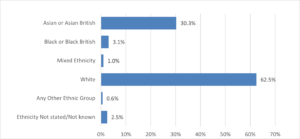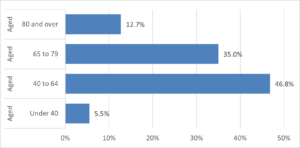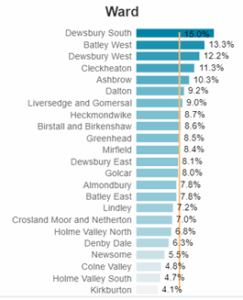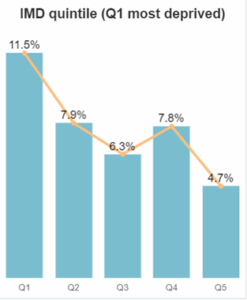Diabetes
2 minute read
Over 4.4 million people in the UK have diabetes, with type 2 diabetes accounting for 90% of cases, largely driven by obesity, poor diet, and inactivity. In Kirklees, 10% of the population has type 2 diabetes, with higher rates among Asian communities and in deprived areas like Dewsbury South.
National Diabetes Audit data shows Kirklees performs well on some care processes but lags behind national averages in key areas like BMI monitoring, urine albumin testing, and statin use for primary prevention. Younger adults are increasingly affected, prompting targeted programmes like T2DAY for those aged 18–39. Community engagement through Healthwatch and Community Champions has improved awareness and access to services, though barriers like language and lack of awareness persist.
National initiatives such as the NHS Health Check, Diabetes Prevention Programme (NDPP), and Type 2 Diabetes Remission (T2DR) are active locally. Commissioners should consider focusing on prevention, early diagnosis, and reducing health inequalities, with continued collaboration with community partners and primary care to improve outcomes and reduce complications.
Why is it important?
Diabetes is highly relevant to population health in the UK due to its growing prevalence, impact on healthcare costs, and associated complications.
Over 4.4 million people in the UK have been diagnosed with diabetes (Diabetes UK statistics), with around 1.2 million more estimated to be undiagnosed, that’s a rise from 2.9 million in 2013 when the last KJSA was published (Diabetes UK statistics). It was predicted in 2012, that by 2025 diabetes levels would be up to 5 million cases and based on current data this is proving a very good estimate (International Diabetes Federation Atlas).
Type 2 diabetes accounts for approximately 90% of cases and is strongly linked to lifestyle factors like obesity, diet, and physical inactivity.
The prevention of diabetes is crucial because it helps reduce the risk of serious health conditions, improves quality of life, and lowers healthcare costs. Uncontrolled diabetes can lead to heart disease, stroke, kidney failure, nerve damage, and vision loss. Preventing diabetes reduces the risk of these life-threatening conditions. Type 2 diabetes is often linked to obesity, high blood pressure, and high cholesterol, all of which increase the risk of cardiovascular disease. By preventing diabetes, you also reduce the risk of these conditions.
Diabetes treatment and management can be expensive due to medications, hospital visits, and complications. Prevention reduces the financial burden on individuals and healthcare systems. Diabetes prevention strategies, such as eating a balanced diet, staying active, and maintaining a healthy weight, contribute to overall well-being and longevity. Type 2 diabetes is largely preventable through lifestyle changes and early action can make a big difference.
We are now seeing an increase in type 2 diabetes in younger people, and services are now being offered addressing the needs of 18- to 49-year-olds.
Contributing factors
Diabetes is a complex condition influenced by a combination of genetic, lifestyle, and environmental factors. The contributing factors depend on the type of diabetes. Type 1 diabetes (an autoimmune condition) can be based on genetics and family history and type 2 diabetes are in the main based on lifestyle and genetic factors. The main factors being:
- Obesity and being overweight – Excess fat, especially around the abdomen, accounts for 80–85% of the overall risk for developing type 2 diabetes.
- Sedentary lifestyle – Lack of physical activity.
- Unhealthy diet – High intake of processed foods, sugary drinks, and refined carbs increases risk.
- Genetics and family history – A strong genetic component can influence a small percentage of individuals. The risk of developing type 2 diabetes is approximately 15% more likely if one parent has type 2 diabetes, and 75% if both parents have type 2 diabetes (NICE guidance).
- Age – Risk increases after the age of 45, but younger people are now developing it due to obesity and lifestyle.
- Ethnicity – People of Asian, African, and Afro-Caribbean ethnicity are 2–4 times more likely to develop type 2 diabetes than white people (Diabetes UK statistics).
- Gestational diabetes (during pregnancy) – If there is a family history of diabetes, meaning one parent or sibling, this can increase susceptibility.
The other contributing factors for diabetes are:
- Chronic stress, which can increase your cortisol levels, leading to higher blood sugars.
- Sleep disorder – poor sleep can worsen insulin resistance.
- Certain medications such as steroids, antipsychotics, and some diuretics can raise blood sugar.
The Kirklees Picture
National Diabetes Audit
The National Diabetes Audit (NDA), measures the quality of diabetes healthcare in England and Wales and in our local area, against NICE Clinical Guidelines and Quality Standards, predominantly done through eight care processes and three treatment targets.
The eight care processes, which are important markers of improved long-term care of patients with diabetes, are crucial for managing the condition and preventing complications. For adults with diabetes, the three treatment targets, as recommended by NICE, are to achieve an HbA1c level of ≤ 58 mmol/mol, a blood pressure of ≤ 140/80 mmHg, and, for those at high cardiovascular risk, to be prescribed a statin.
A review of 2023/24 National Diabetes Audit for type 2 diabetes was undertaken in Kirklees in 2024/25. The table below provides comparison data of eight care processes and three treatment targets for Kirklees against national and West Yorkshire achievement in 2023/24, based on people diagnosed with diabetes.
Table 1: Diabetes eight Care Processes achievement data in 2023/24
| Kirklees (%) | England (%) | West Yorkshire (%) | |
| HbA1c | 95.4 | 94.3 | 95.3 |
| Blood Pressure | 94.4 | 94.2 | 94.7 |
| Cholesterol | 91.8 | 90.8 | 91.4 |
| Serum Creatinine | 94.9 | 94.2 | 94.9 |
| Urine Albumin | 65.6 | 70.8 | 71.5 |
| Foot Surveillance | 82.9 | 81.2 | 81.2 |
| BMI | 85.2 | 89.3 | 89.8 |
| Smoking | 95.6 | 95.6 | 96.2 |
| All Eight Care Processes | 55.1 | 62.3 | 61.3 |
Table 2: Diabetes three Treatment Targets achievement data in 2023/24 of People Diagnosed with Diabetes
| Kirklees (%) | England (%) | West Yorkshire (%) | |
| HbA1c <= 58 mmol/mol (7.5%) | 62.4 | 64.1 | 61.9 |
| Blood Pressure <= 140/80 | 65.2 | 66 | 66.4 |
| Primary Prevention – On Statins without CVD History | 71.5 | 75.3 | 75.2 |
| Secondary Prevention – On Statins with CVD History | 89.1 | 88.3 | 89.3 |
| Combined Prevention – On Statins | 76.1 | 78.6 | 78.9 |
| All Three Treatment Targets | 33.9 | 36.4 | 35.2 |
The review has highlighted that Kirklees’s achievement has been lower in some metrics as compared to West Yorkshire and nationally. Three indicators – urine albumin, Body Mass Index (BMI) and primary prevention with statins – have been identified as focus areas in Kirklees for 2025/26. The primary care team in Kirklees are being supported in 2025/26 to monitor and improve achievement in these three indicators to bring Kirklees in line with national achievement target. This will improve quality of diabetes care being provided in Kirklees and overall reduce complications for patients in later years.
Who is most affected (demographic variance)?
Diabetes prevalence in Kirklees, based on ethnicity, is in line with national statistics. in that people of Asian, African, and Afro-Caribbean ethnicity are 2–4 times more likely to develop type 2 diabetes. Figure 1 shows the proportion of type 2 diabetes cases by ethnicity. Just over 60% of type 2 diabetic people in Kirklees are White, and 30% are from an Asian background. This Asian figure is high compared to the 2021 Census population data, which shows 19.4% of the Kirklees population are Asian or Asian British.
Figure 1 : Diagnosed type 2 diabetes cases by ethnic group in Kirklees, 2023/24

As we know, risk increases above the age of 45, but younger people are now developing diabetes due to obesity and lifestyle choices. The below age graph shows that over 40% of those diagnosed in Kirklees are between the ages of 40 to 64, with just over 5% of those diagnosed under the age of 40, and this trajectory is increasing (National Diabetes Audit, 2023-24).
Figure 2 : Diagnosed type 2 diabetes cases by age group in Kirklees, 2023/24

Where are people most affected (geographical variance)?
According to the local data based on ward level, Figure 3 shows that Dewsbury South reports the highest self-reported level of diabetes (15.0%) followed by Batley West (13.3%), Dewsbury West (12.2%) then Cleckheaton (11.3%). The influencing factors such as socioeconomic deprivation and larger South Asian populations play a part in these higher levels. As expected, our more rural areas of Kirklees such as Kirkburton (4.1%), Holme Valley South (4.7%) and Colne Valley (4.8%) report the lowest levels of diabetes.
Over 11% of people living in the most deprived areas of Kirklees have reported a diagnosis of type 2 diabetes, dropping to nearly 5% in the least deprived (Figure 4). Quintiles 2, 3 and 4 show little variation between them.
Figure 3 : Self-reported diabetes prevalence by ward, 2021 Current Living in Kirklees survey

Figure 4 : Self-reported diabetes prevalence by deprivation quintile, 2021 Current Living in Kirklees survey

Local views
Kirklees has worked with local residents and communities through Healthwatch and our Community Champions to gauge people’s understanding of diabetes and their expectations of services. We also have the Kirklees Involve tool, which is there to help us work with local public services to plan and share community involvement work.
Healthwatch Kirklees has worked in partnership with (Third Sector Leaders) Community Champions, reaching over 2,000 people to tackle awareness of diabetes and risk factors, and to look at the challenges and barriers to accessing diabetes services.
The outcomes of one-to-one conversations with diabetic and prediabetic people stated that 117 people reported an increased awareness of services, just under 150 pre diabetic people were informed of the National Diabetes Prevention Programme and nearly 265 diabetic and pre diabetic people were signposted to local activities related to diabetes (Healthwatch Kirklees/Third Sector Leaders Community Champions diabetes report). See Table 3.
Table 3 : Outcomes of one-to-one conversations, diabetic and pre diabetic (count of people)
| Outcome of conversation | Diabetic | Pre diabetic |
| Improved awareness | 117 | 67 |
| Informed of NDPP | 306 | 147 |
| Signposted to local activities related to diabetes | 179 | 84 |
| Signposted to other services | 184 | 60 |
| Advised to contact GP | 239 | 92 |
| Signposted to diabetes group | 116 | 47 |
| Different reason | 11 | 2 |
The project engaged with non-diabetic people and people unaware of their status (See Table 4), and this engagement saw 878 people reporting a greater understanding of diabetes and services. It also signposted over 600 people to local support and advice services (Healthwatch Kirklees/Third Sector Leaders Community Champions diabetes report).
Table 4 : Outcomes of one-to-one conversations, not diabetic and unknown diabetes status (count of people)
| Outcome of conversation | Didn’t know | Not diabetic |
| Improved awareness | 226 | 878 |
| Informed of NDPP | 79 | 320 |
| Signposted to local activities related to diabetes | 84 | 176 |
| Signposted to other services | 91 | 156 |
| Advised to contact GP | 106 | 108 |
| Signposted to diabetes group | 36 | 72 |
| Different reason | 7 | 9 |
Regarding barriers to accessing support, 461 respondents (41%) stated barriers to support are not applicable to them. However, the remaining 59% identified multiple barriers that prevented them from accessing support/services as their reason for not engaging. The top 5 reported barriers faced by individuals were:
1) Lack of awareness of services/support available (22%)
2) Didn’t understand the importance (20%)
3) Assumed not at risk (13%)
4) Language barrier (12%)
5) Time constraints (12%)
See: Healthwatch Kirklees/Third Sector Leaders Community Champions diabetes report.
What is being done? / what can be done?
There are national programmes available for individuals in Kirklees that are living with diabetes and those that are diagnosed pre-diabetic. In Kirklees, 10% of the population are living with type 2 diabetes, and 9% are living with pre-diabetes who are more at risk of developing type 2 diabetes if they do not change their diet and lifestyle.
NHS Health Check
If you are registered with a GP, you will automatically be invited for a Health Check once every five years between the ages of 40 and 74. Once you get your invitation, simply follow the instructions to book your appointment. Alternatively, you can request to have an NHS Health Check by contacting your GP surgery.
The NHS Health Check is a simple check of your heart health. Aimed at adults in England aged 40 to 74, it checks your vascular or circulatory health and works out your risk of developing some of the most disabling – but preventable – illnesses such as diabetes. It is free of charge, including any follow-up tests or appointments.
National Diabetes Prevention Programme (NDPP)
This programme was developed in 2019 by NHS England to support those that have pre-diabetes to change their lifestyle, facilitated by specialist health and wellbeing coaches. In the past 2 years, Kirklees have referred over 6,000 people. A case study was produced in Kirklees for completers of the programme, which showed that 40% of those individuals have reduced their risk of developing type 2 diabetes.
As part of Diabetes Prevention Week and Diabetes Awareness Day, colleagues in primary care put together notice boards of information and provided staff to support this if more information was required.
Community Champions have been integral to the work within Kirklees, especially around community involvement and peer to peer support groups, and particularly in the areas of Kirklees with the highest prevalence of diabetes. As part of this work, several community groups established cooking classes, healthy weight sessions, yoga and exercise classes. These sessions proved a very important part of people’s lives, getting the support in a friendly, familiar and comfortable environment and sharing experiences.
Type 2 Diabetes Remission (T2DR)
For individuals that have already been diagnosed with type 2 diabetes and meet the criteria, this programme helps support those with type 2 diabetes in improving health whilst living with diabetes and reduce diabetes medication and potentially put their type 2 diabetes into remission. Over the past 2 years there has been around 1,000 referrals in Kirklees. Out of those eligible referrals, 600 people have started the programme, which will contribute to those individuals becoming healthier.
There is currently a pilot running with T2DR, called Empower. This pilot provides access to mental wellbeing support sessions for those who are participating in the programme if they feel they need further support.
NHS Digital Weight Management Programme (DWMP)
This programme supports adults living with obesity who also have a diagnosis of diabetes, hypertension or both, to manage their weight and improve their health.
Engagement in the community has been a focus within Kirklees to inform people that there is support to help them change their lifestyle and become healthier. Reed, the NDPP provider, and Xyla, theT2DR provider, have worked with communities across Kirklees to inform them of the programmes they provide. This includes an event at a local mosque in Greenwood PCN, which was very well attended and had positive feedback.
DWMP attended the Great Big Get Together in Spen Valley and other community groups in Huddersfield. As part of further work with the population who have had a history of gestational diabetes (diabetes in pregnancy), Reed attended the Calderdale and Huddersfield Foundation Trust hospital sites’ maternity wards to inform people who have gestational diabetes that the NDPP is available to those individuals post pregnancy.
Type 2 Diabetes in the Young (T2DAY) Programme
This nationally funded two-year initiative to improve care and outcomes for people aged 18-39 years old with early onset type 2 diabetes (EOT2D) was rolled out in November 2023 across West Yorkshire. Approximately 160,000 people nationally, and 1,400 in Kirklees, fall within this cohort. Under the programme, patients benefit from extra one-to-one reviews to optimise their diabetes care as well as the option of new medicines and treatments where indicated, to help better manage their diabetes. Full evaluation of the T2DAY programme is yet to be concluded but the mid-review of the outcomes data across West Yorkshire up to January 2025 suggests taking action to deliver the four recommendations below to improve outcomes for people living with EOT2D:
- Optimise cardiovascular disease prevention through statin prescribing – aim 35% on statins (Kirklees – within EOT2D population, achieving 21%)
- Increase % with blood pressure treated to target <=140/90mmHg. Aim 90% to target (Kirklees currently achieving 85%)
- Review all patients with HbA1c > 75: consider advice and guidance, specialist review (Kirklees: 25% of EOT2D patients have HbA1c >75)
- Optimise care process attainment: target HbA1c, BP, cholesterol initially (Kirklees: 72% of EOT2D population attaining these 3 care processes; 12% achieving 3 treatment targets)
Primary care in Kirklees is being supported to enact the recommendations for those with EOT2D, which will deliver improved outcomes for people with EOT2D and reduce health inequalities.
What commissioners and service planners could consider?
The national programmes commissioned by NHS England will continue to March 2026, with a potential of extending these contracts, depending on the NHS priorities set out within the Long-Term Plan. However, diabetes will still be a focus in Kirklees
Working with Community Champions on the diabetes campaign has been a great opportunity and going forward would continue to work with them. The Healthwatch intelligence has identified where there are gaps, and the ICB will need to focus their efforts in particular areas of Kirklees.
The Living Well Programme will focus on prevention, early identification and secondary prevention, and underpinning those workstreams will be health inequalities.
A review of the National Diabetes Audit, mentioned earlier, has resulted in improving diabetes care. However, there are still areas such as the 3 treatment targets, that need focus in the next couple of years.
Diabetes is included as one of the ICB’s key areas for prevention, both for primary and secondary care, in the Living Well Programme, covering topics such as smoking, healthy weight and NDPP.
Under secondary prevention, the ICB’s key focus is early identification and diagnosis. T2DR and the work the ICB will be focusing on over the next two years with primary care will help to improve the identified metrics from National Diabetes Audit, including structured education for newly diagnosed patients. The ICB will be optimising treatment in primary care and through our locally enhanced service for diabetes injectables.
References and additional resources
International Diabetes Federation Atlas
National Diabetes Audit, 2023-24
Kirklees Council, 2021 Current Living in Kirklees (CLiK) Survey
Healthwatch Kirklees/Third Sector Leaders Community Champions diabetes report
See also: KJSA sections on Living Well and Ageing Well
Date updated (and lead author initials): 23/07/25 (MH)
